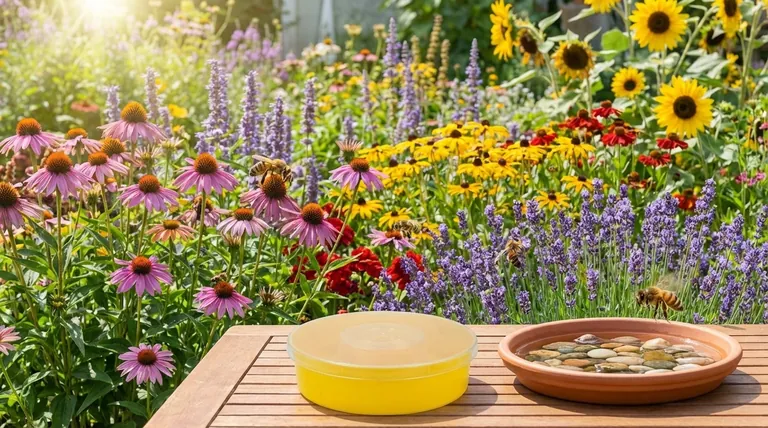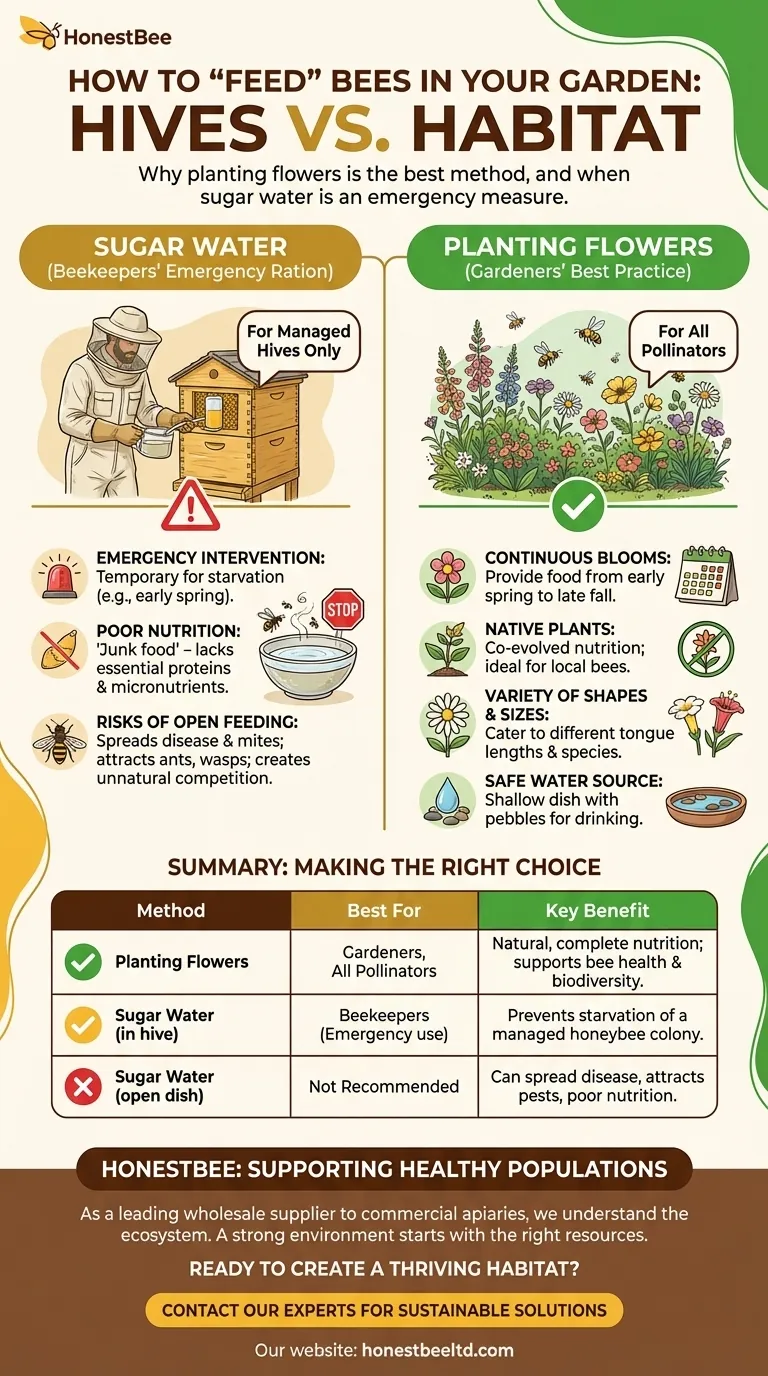While you can feed bees a simple 1:1 mixture of sugar and water, this practice is almost exclusively for beekeepers managing weak or newly established hives. For a gardener, providing an open source of sugar water can cause more harm than good, as it offers poor nutrition and can promote the spread of disease among wild bee populations.
The most effective and sustainable way to "feed" bees in your garden is not with sugar water, but by planting a diverse range of nectar-rich flowers. This creates a natural, healthy, and reliable food source that supports a wide variety of pollinators.

Why Sugar Water is for Hives, Not Gardens
The advice to feed bees sugar syrup is specific to beekeeping. It serves as an emergency intervention when a honeybee colony's natural food stores are insufficient.
An Emergency Ration for Honeybees
Beekeepers use sugar syrup during critical periods, such as in early spring before flowers have bloomed or when establishing a new colony. This is a targeted, temporary measure to prevent a specific hive from starving.
The Problem with "Open Feeding" in a Garden
Placing a dish of sugar water in your garden is known as open feeding. This creates intense competition, drawing bees from a wide area to a single point.
This unnatural concentration can facilitate the rapid spread of diseases and mites between different bee populations. It also provides the equivalent of "junk food," lacking the essential proteins and micronutrients found in natural nectar.
The Best Way to Feed Bees: Plant a Buffet
Your goal should be to create a landscape that provides natural, high-quality forage. A garden filled with the right plants is the healthiest and most effective bee feeder you can create.
Focus on Continuous Blooms
Bees need food from early spring through late fall. Plant a variety of species so that as one plant finishes flowering, another begins.
This provides a consistent and reliable food source for the entire season, supporting bee populations through their full life cycle.
Prioritize Native Plants
Native plants and local bees have co-evolved over millennia. These plants are perfectly suited to provide the ideal nutrition for the bees in your specific region.
Offer a Variety of Shapes and Sizes
Different bee species have different tongue lengths and body sizes. Planting a mix of flower shapes—from open-faced daisies to deep, tubular blossoms—ensures you are feeding a wider variety of pollinators.
Don't Forget a Water Source
Bees get thirsty, too. A simple, shallow dish filled with pebbles, marbles, or twigs and a little water provides a safe place for them to land and drink without the risk of drowning.
Understanding the Trade-offs
While well-intentioned, providing artificial food sources comes with significant downsides that often outweigh the perceived benefits for a home gardener.
Attracting Unwanted Guests
An open dish of sugar water is not just attractive to bees. It will also draw ants, wasps, and hornets, which can predate on bees and become a nuisance in your garden.
Creating Dependency and Competition
An easy, artificial food source can distract bees from pollinating the very plants you want them to visit. It can also favor larger, more aggressive species like honeybees over smaller, solitary native bees.
Making the Right Choice for Your Goal
- If your primary focus is to support local wildlife and native pollinators: Plant a succession of diverse, native flowers and provide a safe water source.
- If you are a beekeeper managing a struggling hive: Use a 1:1 sugar-water solution inside a dedicated hive feeder, not in an open dish.
- If you simply want to help the bees you see in your yard: The single best action is to add more flowering plants to your garden or patio containers.
By cultivating a thriving floral ecosystem, you provide the complete, natural nutrition that truly helps all bees prosper.
Summary Table:
| Method | Best For | Key Benefit |
|---|---|---|
| Planting Flowers | Gardeners, All Pollinators | Provides natural, complete nutrition; supports bee health and biodiversity. |
| Sugar Water (in hive) | Beekeepers (emergency use) | Prevents starvation of a managed honeybee colony when natural food is scarce. |
| Sugar Water (open dish) | Not Recommended | Can spread disease, attracts pests, offers poor nutrition ('bee junk food'). |
Ready to create a thriving habitat for pollinators?
As a leading wholesale supplier to commercial apiaries and beekeeping equipment distributors, HONESTBEE understands what it takes to support healthy, productive bee populations. While our core business focuses on large-scale operations, the principle remains the same: a strong ecosystem starts with the right resources.
Let us help you build a better environment for bees. Contact our experts today to discuss sustainable solutions.
Visual Guide

Related Products
- HONESTBEE Round Hive Top Bee Feeder for Syrup
- Classic Boardman Entrance Bee Feeder Hive Front Feeding Solution
- HONESTBEE Entrance Bee Feeder Professional Hive Nutrition Solution for Beekeeping
- Professional Hive Top Bee Feeder for Beekeeping
- HONESTBEE Entrance Bee Feeder Efficient Hive Front Liquid Feeding Solution for Beekeeping
People Also Ask
- What types of hive boxes is the round hive top feeder compatible with? Universal Fit for 8 & 10-Frame Langstroth Hives
- What are the features of top feeders for bees? Maximize Hive Health with Safe, High-Capacity Feeding
- How should syrup for bees be prepared? Master the Ratio for a Thriving Hive
- Why is a top feeder essential for bees? Ensure Colony Health and Efficiency
- What can the round hive top feeder be used for? A Guide to Efficient, Safe Bee Feeding



















